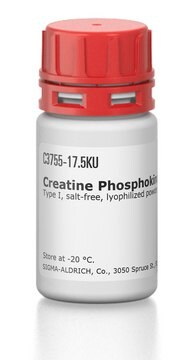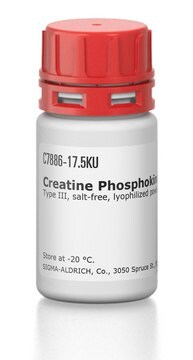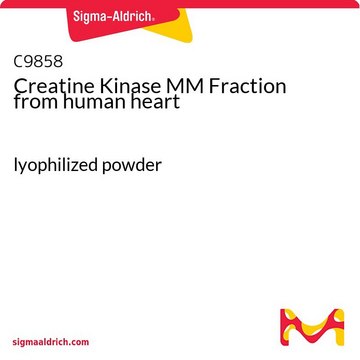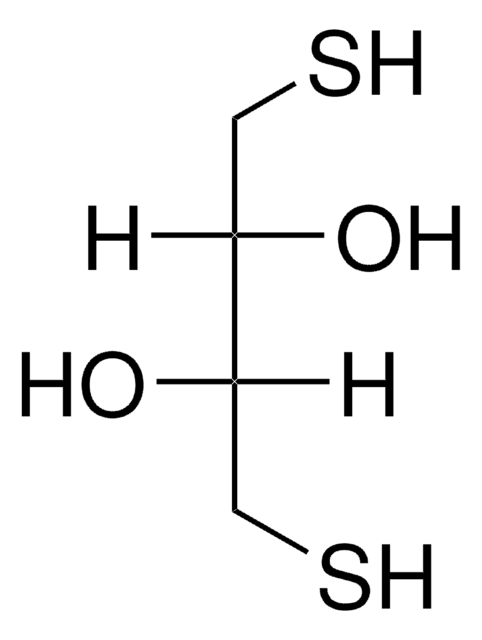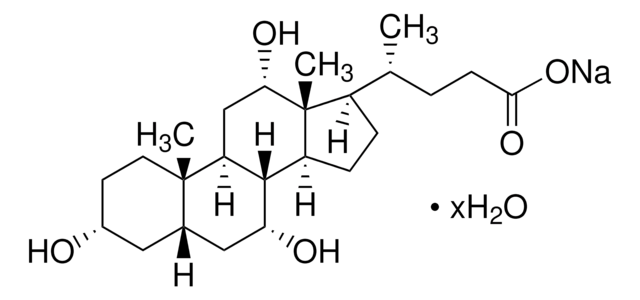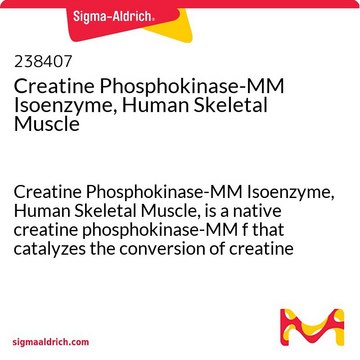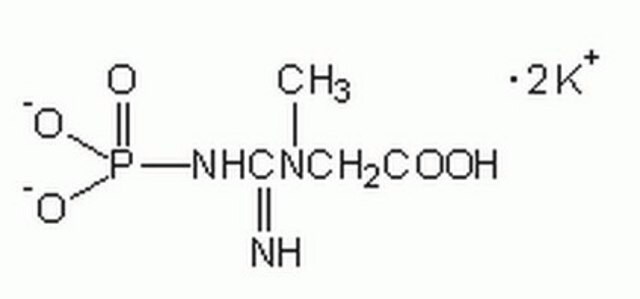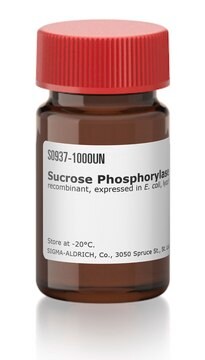CK-RO
Roche
Creatine Kinase (CK)
from rabbit muscle
Sinonimo/i:
creatine phosphokinase
Autenticatiper visualizzare i prezzi riservati alla tua organizzazione & contrattuali
About This Item
Prodotti consigliati
Origine biologica
rabbit muscle
Livello qualitativo
Stato
lyophilized
Confezionamento
pkg of 100 mg (10127566001)
pkg of 500 mg (10736988001)
Produttore/marchio commerciale
Roche
Colore
white to light yellow
pH ottimale
6.0-7.0(reverse reaction)
9.0(forward reaction)
Solubilità
water: soluble
Compatibilità
suitable for immunoprecipitation
N° accesso NCBI
N° accesso UniProt
applicazioni
life science and biopharma
sample preparation
Attività estranea
ATPase <0.001%
HK <0.001%
myokinase <0.001%
Temperatura di conservazione
2-8°C
Informazioni sul gene
rabbit ... CKM(100009056)
Descrizione generale
at 25 °C (800 U/mg lyophilizate at 37 °C) with creatine phosphate and ADP as the substrates, and N-acetyl-L-cysteine as the activator.
Applicazioni
Creatine kinase has been used as a component of translation buffer used in in vitro translation assay and as a component of energy regeneration mix.
Azioni biochim/fisiol
Creatine kinase (CK) is a guanidino-kinase that catalyzes the reversible phosphorylation of creatine to phosphocreatine at the expense of ATP. It plays crucial roles in rapid regeneration of ATP in cells with high demand for energy. Increased level of CK in human blood indicates diseases of the nervous system and the heart muscle, malignant hypothermia, and certain tumors. Metals such as Mg, Mn and Ca act as cofactors for CK. It also forms a substrate for protein kinase C, an important signaling molecule involved in cell growth. A product of enzymatic reaction of CK, phosphocreatine, is found to prevent HIV (human immunodeficiency virus) replication in macrophages.
Qualità
Contaminants: <0.001% ATPase, HK, and myokinase, each
Specifiche
Specific activity: Approximately 350U/mg lyophilizate at +25°C (800U/mg lyophilizate at +37°C) with creatine phosphate and ADP as the substrates, and N-acetyl-L-cysteine as activator.
Definizione di unità
One unit CK activity (+25 °C) = 2.3 U (+37 °C), creatin-P and ADP as substrates, NAcCys as reactivator.
Stato fisico
Lyophilizate, stabilized
Nota sulla preparazione
Storage conditions (working solution): Working solutions and storage conditions in routine applications:
Dissolve in 0.1 M imidazole buffer; aliquot and store at -15 to -25 °C.
Stable for approximately four weeks at -15 to -25 °C.
Avoid repeated freezing and thawing.
Dissolve in 0.5% NaHCO3 solution.
Do not freeze. Store protected from light.
Stable for 2 - 3 days, when stored at 2 to 8 °C.
Or
Dissolve in 30 mM glycine buffer, pH 9.0, with 0.2 mM DTT.
Stable for 2 - 3 days, when stored at 2 to 8 °C.
Dissolve in 0.1 M imidazole buffer; aliquot and store at -15 to -25 °C.
Stable for approximately four weeks at -15 to -25 °C.
Avoid repeated freezing and thawing.
Dissolve in 0.5% NaHCO3 solution.
Do not freeze. Store protected from light.
Stable for 2 - 3 days, when stored at 2 to 8 °C.
Or
Dissolve in 30 mM glycine buffer, pH 9.0, with 0.2 mM DTT.
Stable for 2 - 3 days, when stored at 2 to 8 °C.
Altre note
For life science research only. Not for use in diagnostic procedures.
Codice della classe di stoccaggio
11 - Combustible Solids
Classe di pericolosità dell'acqua (WGK)
WGK 1
Punto d’infiammabilità (°F)
does not flash
Punto d’infiammabilità (°C)
does not flash
Scegli una delle versioni più recenti:
Possiedi già questo prodotto?
I documenti relativi ai prodotti acquistati recentemente sono disponibili nell’Archivio dei documenti.
I clienti hanno visto anche
Aurélie M Rakotondrafara et al.
Nature protocols, 6(5), 563-571 (2011-04-30)
Much of the regulation of gene expression occurs at the level of protein synthesis. In addition to the canonical translation factors, a multitude of proteins and microRNAs (miRNAs) act as regulatory trans-acting factors. Mechanistic analysis of translational control benefits from
Irina M Kuznetsova et al.
Biochimica et biophysica acta, 1596(1), 138-155 (2002-05-02)
GdmCl-induced unfolding of rabbit muscle creatine kinase, CK, has been studied by a variety of physico-chemical methods including near and far UV CD, SEC, intrinsic fluorescence (intensity, anisotropy and lifetime) as well as intensity and lifetime of bound ANS fluorescence.
J K Rao et al.
FEBS letters, 439(1-2), 133-137 (1998-12-16)
The crystal structure of rabbit muscle creatine kinase, solved at 2.35 A resolution by X-ray diffraction methods, clearly identified the active site with bound sulfates surrounded by a constellation of arginine residues. The putative binding site of creatine, which is
Marta Teperek et al.
International journal of molecular sciences, 15(9), 16719-16740 (2014-09-23)
Spermatozoa are more efficient at supporting normal embryonic development than spermatids, their immature, immediate precursors. This suggests that the sperm acquires the ability to support embryonic development during spermiogenesis (spermatid to sperm maturation). Here, using Xenopus laevis as a model
Marta Teperek et al.
Genome research, 26(8), 1034-1046 (2016-04-02)
For a long time, it has been assumed that the only role of sperm at fertilization is to introduce the male genome into the egg. Recently, ideas have emerged that the epigenetic state of the sperm nucleus could influence transcription
Il team dei nostri ricercatori vanta grande esperienza in tutte le aree della ricerca quali Life Science, scienza dei materiali, sintesi chimica, cromatografia, discipline analitiche, ecc..
Contatta l'Assistenza Tecnica.